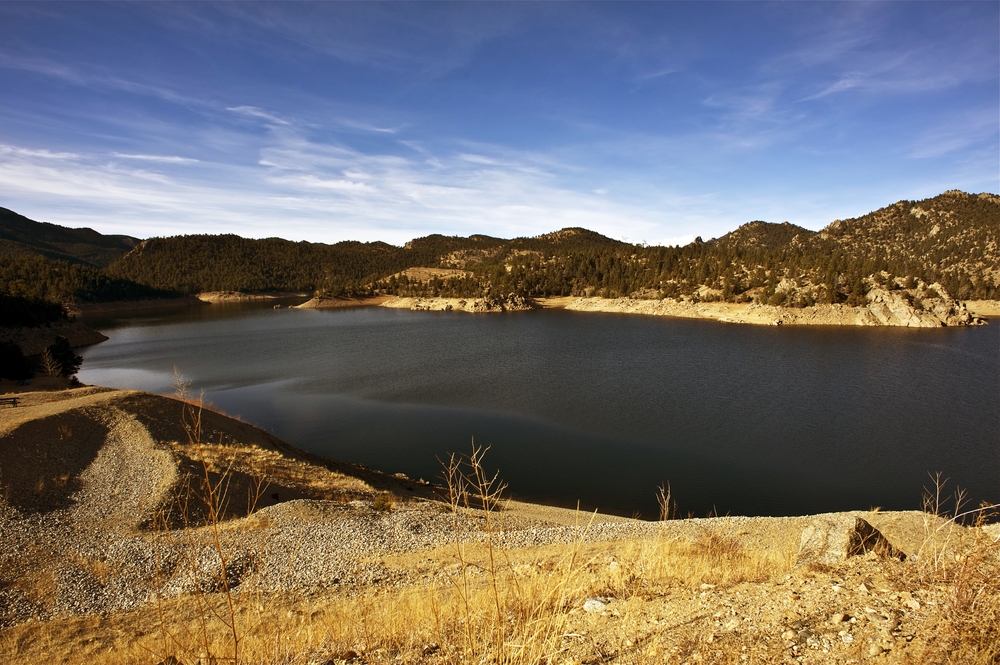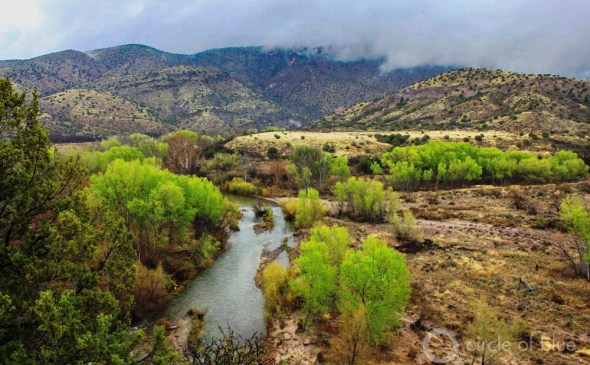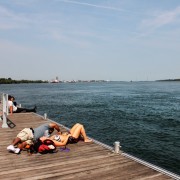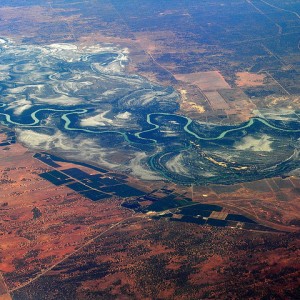Guess Who Proposed the Missouri River Pipeline in the Federal Government’s Colorado River Basin Study?
Hint: It’s not who you might think, says Circle of Blue reporter Brett Walton.

Last December, the federal Bureau of Reclamation published a landmark study of water supply and demand in the Colorado River Basin. Included as a supply option was a pipeline from the Missouri River in Kansas to Colorado’s Front Range.
Neither Kansas nor the Front Range, a string of cities east of the Continental Divide, lies within the natural boundaries of the Colorado River, which flows west out of the Rocky Mountains. As it turns out, the man who proposed the pipeline does not live in the river’s watershed either. Yet all three — Kansas, the Front Range, and the pipeline advocate — are connected by Colorado River water.
That connection is the wonder and the marvel and the madness of the American West, a region whose diverse economies and ecosystems are linked by concrete and steel conduits that move water beyond borders.
End of the Line
“We created the largest artificial watershed in the world,” says Pat Mulroy, the powerful head of the Southern Nevada Water Authority, a wholesaler that supplies Las Vegas.
Water from the Colorado River is piped across deserts, channeled through mountains, and — after being treated in local sewage plants — winds up in rivers that flow to the southern ends of the country:
- Some of New Mexico’s share goes into the Rio Grande, eventually flowing south and east through Texas and into the Gulf of Mexico.
- What Denver returns to nature flows into the South Platte, a tributary of the Missouri River.
- The coastal cities of Southern California dump a good bit of their diversion into the Pacific Ocean.
None of these water bodies is the logical end of the line for the Colorado River, whose natural terminus is a delta at the northern crook of the Gulf of California. A delta that is, ironically, all dried up.
Expanding the Web
The river’s web, if some have their way, could become even larger. John Kaufman, the man who proposed the Missouri River pipeline, wants to see the artificial boundaries expand. Kaufman is the general manager of Leavenworth Water, which serves 50,000 people in a town that welcomed Lewis and Clark in 1804 during the duo’s westward exploration.
The identity of the pipeline’s proponent, who was anonymous during the Bureau of Reclamation study and is for the first time being named in the media, is important because of where he lives — outside of the natural Colorado River Basin, or in the extended web.
–John Kaufman, general manager
Leavenworth Water
In Kaufman’s vision, Kansas becomes a hydrological keystone for the West, facilitating water transfers that could affect at least 10 states and Mexico.
“We’d hopscotch water across Kansas and sell it to communities in the state,” Kaufman told me during a phone interview last month, explaining the benefit to his home territory. Construction of the pipeline would also supply jobs to Leavenworth, where the intake facilities would be located. At least one groundwater district in western Kansas is advocating for a similar concept, a Missouri River pipeline to the High Plains to compensate for declines in the Ogallala Aquifer, an essential source for irrigation. Kaufman has presented his idea to state and local officials several times this year.
Once the water flows past Kansas, “it’s a horse trade,” Kaufman said. Water delivered to the Front Range would be earmarked for the South Platte River Basin, which includes Denver. (The South Platte, remember, is part of the Missouri River Basin.) A pipeline would close the circle, sending South Platte water, via the Missouri, back uphill. Of course a few drops of the Colorado would be in the pipe, too.
“It’s a reuse project, really,” said Kaufman, who serves on Kansas governor Sam Brownback’s Missouri River advisory committee.
Kansas: Interstate Highways and Interstate Waterways?
Then there are the swaps. Front Range cities get roughly 72 percent of their supplies from the Colorado River, according to a 2009 study commissioned by the Front Range Water Council. If water from the Missouri were imported, then some of the trans-Rocky diversions could remain within the Colorado River Basin.
Kaufman’s idea — he calls it the Eisenhower Pipeline, in honor of the sponsor of the interstate highway system, which got its start in Kansas — was included in the Bureau of Reclamation’s final report, but top federal officials distanced themselves from the project, once word leaked a few days before the report’s official release last December.
“In my view, [water import] solutions are impractical and not feasible,” said Ken Salazar, Secretary of the Interior at the time. The study actually gave the pipeline high marks for technical feasibility, but the $US 8.6 billion price tag and the high energy costs pushed the pipeline to the bottom of the pile. Conservation was the big winner, deemed to be significantly cheaper and able to deliver more water.
Kaufman knows the scheme is expensive, which is why he says that he needs financial buy-in from the states in the Colorado’s Lower Basin and cooperative agreements among all the Basin states in order to shuffle water supplies.
“It’s not about providing water to the Front Range,” he said. “It’s about providing water to the West.”
Clipping Wings or Taking Flight?
Kaufman may be tilting at water pipes here. The cost is enough to clip the pipeline’s wings, especially when the federal government is shying away from investing in these types of projects unless they involve tribal water settlements. Just as daunting are the interstate political and permitting mazes.
But we should still pay attention to these ideas.
Conservation and reuse are the dominant narratives today and most cities still have significant improvements to make, but Big Infrastructure is not going away, as I’ll soon report for Circle of Blue.
The projects being built, however, are a lot smaller than what Kaufman proposes and do not cross state lines.
Do you live in either the Missouri or Colorado river basin? What do you think about this plan? Let me know directly at Brett Walton’s page or on Twitter @waltonwater or by commenting below.
–Brett Walton, Circle of Blue reporter
Brett writes about agriculture, energy, infrastructure, and the politics and economics of water in the United States. He also writes the Federal Water Tap, Circle of Blue’s weekly digest of U.S. government water news. He is the winner of two Society of Environmental Journalists reporting awards, one of the top honors in American environmental journalism: first place for explanatory reporting for a series on septic system pollution in the United States(2016) and third place for beat reporting in a small market (2014). He received the Sierra Club’s Distinguished Service Award in 2018. Brett lives in Seattle, where he hikes the mountains and bakes pies. Contact Brett Walton










I think they concept makes great sense. By supplying Missouri River water to the front range you can drastically reduce dependence on trans-mountain diversions from the Colorado River. The diversions can be used as a cheap redundant source (since the infrastructure is already in place) to supplement Front Range demand in times the Missouri River pipeline is down or in times of drought conditions impacting the Missouri River, when the Rockies tend to see greater snowfall amounts. Conservation will only go so far. A alternate supply of raw water is necessary in order to sustain growth and protect against periodic or extended periods of drought. In addition, de-sal along the Pacific coast will be instrumental in bolstering the supply of raw water to western states. A multi-state plan should be studied that provides a long-term solution to providing water supply redundancy to serve states west of the Mississippi. The longer we wait the more expensive the project becomes to construct and anyone that thinks a long term solution is conservation is vastly mistaken.
It will cost too much to pump water up the Rockies. Instead, have the Boring Co dig a 14ft tunnel from Pickstown, Missouri all the way to Lake Mead which conveniently sits 250′ lower in elevation. It would flow with no energy input. It could be set up to only flow during flood stage. The Midwest gets much needed flood relief, and Vegas/LA/Mexico get much needed water. Now, there are at least 3 major problems with this:
1) Cost: Even with Boring company best case advances, the cost of this 950 mile tunnel will still be $9.5 Billion.
2) Flow. Friction in the tunnel reduces its flow to 150 Million Gallons per day. While this seems like a lot, Lake Mead loses over 800 Million gallons per day to evaporation.
3) Induced Demand. If a tunnel could be built to flow enough water, it would only encourage more development and more water use to the point of running out again. Water prices need to go up in areas that don’t have water to discourage new homes there. Build where there is plenty of water instead- problem solved.
Building a water supply tunnel from the Missouri to Lake Mead would cost billions but create 10’s of thousands of well paid jobs. Evaporation at Lake Mead could be dramatically reduced by installing large area of floating solar panel arrays, again costly but affordable and a large source of clean renewable energy and more green jobs. The extracted water especially during flood periods helps protect everyone in a flood area downstream of the Missouri and Mississippi River basins. Vast areas of inexpensive desert land could be covered with industrial glasshouses for food production making optimum use of the additional water supply. In light of the spending proposed under President Biden’s New Green Deal, this project is an absolute bargain!
Someone needs to think about the revenue that is going to be lost if nothing is done. Think about the loss of power generation charges, loss of employment at the Dam’s, numerous other associated items I.e. recreation, towns, businesses etc. all drying up.
As far as the evaporation is concerned I question the amount stated. I can see the 800 million gallons when the Reservoir is full and we have one of our record heat days but not a normal day.
Another plus would be when the river is going to flood you would have a way to draw the water down.
Their are people out there that think of more benefits vs con,s than me.
Some one has to think where are all our new populations going to live, some cities you can hardly move in them at all.
I have gone on way to much.
Thanks
Bob;
Are you sure about those evaporation numbers? The project could be a very good one, but your numbers come out to 2,500 acre feet a day – 900,000 acre feet per year (afy). I don’t remember the whole Colorado System losing that much – though it has been a while since I looked at those numbers. Nevertheless, we need more water in the system…
Rudy